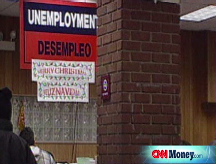Fed begins business lending program
Government loaning huge amounts to businesses. The aim: Ease short-term financing fears at a volatile time.
NEW YORK (CNNMoney.com) -- The Federal Reserve started buying so-called commercial paper on Monday to jumpstart a critical but faltering lending market used by banks and big businesses.
To boost the $1.45 trillion pool of money - which was about $2 trillion a year ago - the Fed has begun buying high-quality commercial paper with a maturation period of three months. The program, known as the Commercial Paper Funding Facility (CPFF), will continue through the end of April 2009.
"This will be a vital facility until corporations can find an alternative," said Bill Larkin, portfolio manager at Cabot Money Management. "Companies can't operate without access to the commercial paper markets."
Several dozen companies registered for the Fed's program, including General Electric Co. (GE, Fortune 500), which is reportedly the largest issuer of commercial paper. Morgan Stanley (MS, Fortune 500) topped the name of Wall Street firms that registered. Car and home financer GMAC (GMA) said it was approved to make use of the facility, and American Express (AXP, Fortune 500) said it intends to use the facility as early as this week, but it did not yet sell paper to the Fed.
"American Express is always interested in broadening its sources of funding, and the CPFF provides us with access to a reliable source of short-term funding beyond 30 days," said company spokeswoman Jo Lambert.
The Fed could buy about $250 billion of paper to restore the market to its pre-credit-crisis levels, according to Lyle Gramley, a former Fed governor and current Stanford Group economist. And the number of participating companies - and the amount of paper that the Fed will buy up - could grow in coming weeks and months.
The Fed said it will not cap the total amount it lends out, but the central bank will limit purchases of companies' debt to the greatest amount of paper the company had outstanding this year. The amount of paper that the Fed bought will not be known until Thursday, when the central bank will make a weekly announcement about the facility's cost.
Commercial paper is short-term debt that big businesses and financial institutions sell primarily to money-market fund managers and other institutional investors. The companies use the loans to fund day-to-day business operations, but the market has dried up as confidence on Wall Street has waned.
Since Lehman Brothers filed for bankruptcy on Sept. 15, total commercial paper has plunged by 20% - the greatest drop on record. Commercial paper outstanding is now at its lowest point since April 2005.
"The problem has grown in scope and magnitude over the past month more than anyone could have imagined," said Scott Anderson, senior economist with Wells Fargo. "Liquidity is freezing up in the short-term lending market, which can snowball very quickly into payroll cuts and other nasty developments."
Three-month paper has found the fewest buyers. Investors are worried that they'll end up holding debt for a company that won't be able to pay them back - or won't be there at all at the end of the maturation period. The vast majority of outstanding paper matures in a week or less, so companies have been forced to refinance their debt weekly - or even daily - and many have not been able to meet their credit needs. The lack of longer-term lending is worrisome for companies looking for financing for the last few months of the year.
The fourth quarter is the most critical period for lending, as financial institutions are hesitant to lend with the risk of taking a hit to their balance sheets at the end of the fiscal year. Uncertainty over the looming election has also made investors weary of doling out their funds.
The central bank will charge a floating interest rate that will begin at 1.88% for unsecured debt and 3.88% for asset-backed commercial paper. Paper of lower credit quality is often backed with assets to entice borrowing, but rates are higher. The Fed's rates are competitive with current market rates and are lower than the 2.5% to 5% that borrowers were charged when the credit crisis first took hold in mid-September.
Some economists believe that the Fed's commercial paper rates will nudge other rates lower, like the 3-month Libor interbank lending rate, which currently sits at a high 3.51% level. That would be a major boost for the strangled credit market, as more than $350 trillion is assets are tied to Libor.
"The goal of the central banks is to lower Libor rates, because borrowing is so expensive for companies now," Anderson said. "There is no one magic solution, but this program will help lead to lower rates."
The Fed's actions have been criticized by some analysts who believe the facility doesn't address the sellers of lower quality paper, who have suffered the most since the credit crisis put a stranglehold on lending. Still, other economists say the Fed's efforts to buy up large amounts of commercial paper will restore confidence to the market. ![]()



